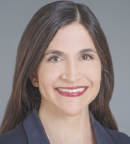Two major developments in oncology—the dramatic success of some immunotherapies and targeted drugs and an equally dramatic rise in the cost of care—have created policy issues, more serious than ever, regarding access to care.

Louis M. Weiner, MD
It is a time “of extraordinary opportunities combined with inequities in access,” said Louis M. Weiner, MD, Director of Georgetown Lombardi Comprehensive Cancer Center, who gave the opening talk at a policy briefing convened by Lombardi’s Ruesch Center for the Cure of Gastrointestinal Cancers in Washington, DC.
“Strategies to reduce costs,” he added, “are among the most important issues.”
Variety of Strategies
The discussions that followed covered a variety of strategies. They ranged from one already in development—ASCO’s value framework, a decision-making tool for the clinic—to a newly launched proposal to link the duration of patent protection to the efficacy of a drug.

Jeanne Ruesch
The Ruesch Center has organized policy briefings since its establishment in 2009, said Jeanne Ruesch, Chair of the Ruesch Family Foundation. In recent years, the meetings have explored various aspects of rising costs and how to define value in cancer care. With the field changing so quickly, she said, “these are fundamentally important issues.”
Driving the concern about costs and value is the affordability of drugs and patient copays. “There are good projections that if trends continue, by 2021 the cost of a family health insurance premium will be equal to 50% of the average family income,” said Dana Wollins, MGC, Senior Director of Health Policy at ASCO, who served on a panel that addressed paying for cancer care.

Dana Wollins, MGC
No one on that panel or at the meeting suggested that higher patient copays were the answer. Proposed strategies were directed instead at bringing down the costs of drugs through the regulatory and patent systems and creating transparency around costs and value.
Value Frameworks
ASCO’s approach to the issue emphasizes value as defined by individual patients. Its value framework will allow patients, with their providers, to compare the efficacy, risks, and costs of therapies for specific cancers. The goal is to provide a greater understanding of “what you get for what you pay,” Ms. Wollins said. “We want to be able to equip patients with that understanding.”
The draft version of ASCO’s value framework elicited more than 400 public comments. Many of them, she said, recommended more information on the toxicity and long-term effects of treatments. An updated framework was published in the Journal of Clinical Oncology earlier this year.1 ASCO is now working to translate it into a user-friendly software tool that physicians can use with patients as part of broader discussions about treatment options, according to a recent statement from ASCO.

John Marshall, MD
Value frameworks have been criticized as a tool that could limit access to care. But limitations are already in place, said John Marshall, MD, Director of the Ruesch Center as well as Clinical Director of Oncology for Georgetown University Hospital and Chief of the Division of Hematology-Oncology. The value framework tools do not limit access further, he said in an interview, but give patients the information they need to weigh drug pros and cons in terms of their own circumstances.
Using a value framework tool is like a car buyer deciding between a Mercedes and a Honda or Toyota, Dr. Marshall said. The individual buyer weighs data on performance and cost to choose the model that is best for him or her. (Analogous examples are of a young breast cancer patient with children for whom efficacy may be paramount and an elderly patient with the same cancer for whom quality of life and perhaps cost may be more important.)

Randy Burkholder
Pharmaceutical companies are also concerned about the value of drugs for individual patients, said Randy Burkholder, Vice President of Policy and Research at the Pharmaceutical Manufacturers Association (PhRMA). It is something the industry is working on, he said. Companies also want to make certain that resources are in place to help eligible patients get assistance, he said, referring to charitable foundations and other kinds of nonprofits.
But charity does not solve the basic problem, said Ms. Wollins. “It is a Band-Aid.”
Drug Approvals and Patents
Another frequently mentioned strategy to reduce costs centers on the U.S. Food and Drug Administration’s requirements for drug approval. Reducing clinical trial requirements and regulations would reduce investment costs for drug companies, said several participants, including Dr. Weiner and Mr. Burkholder.

Howard Dean, MD
Howard Dean, MD, Governor of Vermont from 1991 to 2003 and former Chairman of the Democratic National Committee, also urged less oversight. “Don’t let regulation depress innovation!” he said.
Dr. Dean also noted that the current fee-for-service system creates incentives for expensive tests, such as magnetic resonance imaging, and needs to be reformed. Asked about the medical markup for chemotherapy drugs, he said it was “a bad system.”

M. Gregg Bloche, MD, JD

Neel Sukhatme, PhD
One of the newest proposals for reducing the cost of drugs was presented by two lawyers from the Georgetown University Law Center. M. Gregg Bloche, MD, JD, and Neel Sukhatme, PhD, who said that the duration of drug patents—the time during which drugs are free from competition from generic versions—should be tied to the drug’s value to society. For instance, drugs that had better outcomes in clinical trials might have longer patents. This would tie drug profits to performance, Drs. Bloche and Sukhatme suggested, in the same way that the success of any commercial product is determined by its performance.
Like other proposed strategies to reduce cancer care costs, this one reflects the fact that the issue of cost vs value is a major hurdle for the field, Dr. Marshall said. “Embracing value and transparency is the way over that hurdle.” ■
Disclosure: Drs. Weiner, Marshall, and Dean, Mr. Burkholder, and Ms. Wollins reported no potential conflicts of interest.
Reference

